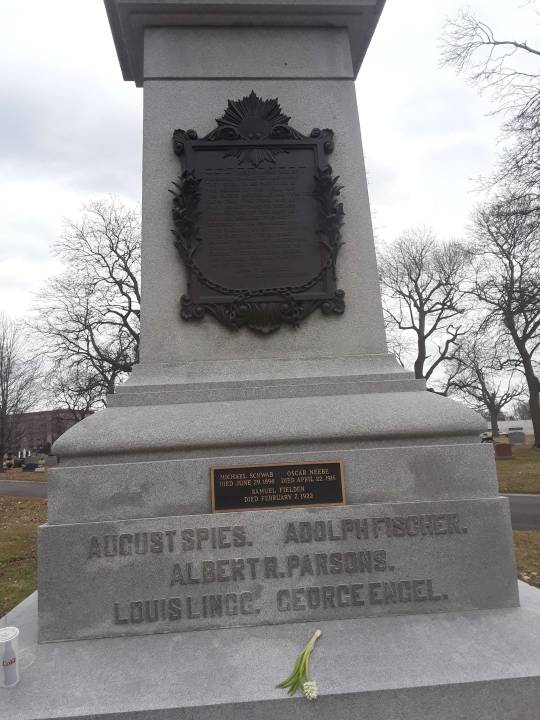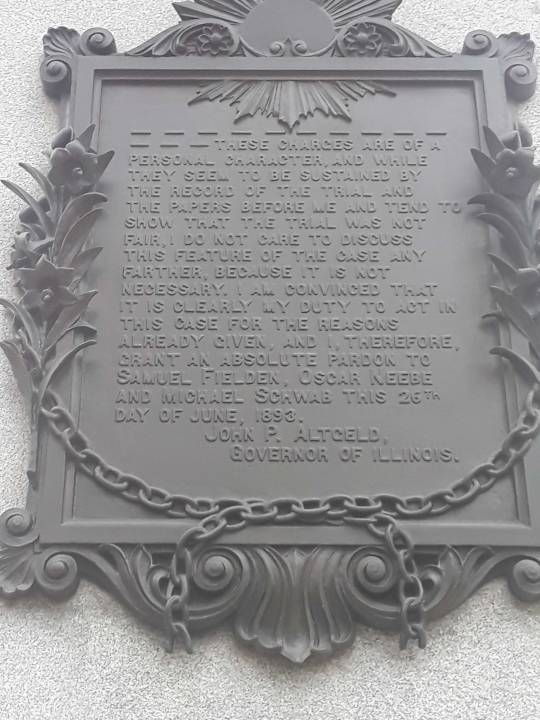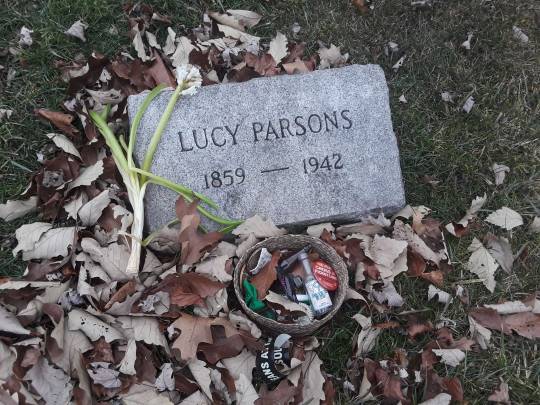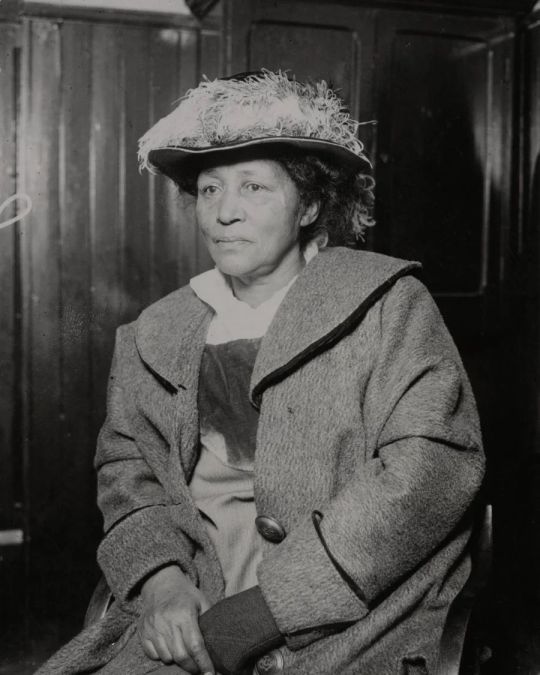#haymarket martyrs
Explore tagged Tumblr posts
Text




#albert parsons#lucy parsons#haymarket#haymarket martyrs#anarchism#the alarm#nat turner#class struggle#carlos fuentes#radical history
19 notes
·
View notes
Text
This Day in Anarchist History: The Haymarket Affair
youtube
5 notes
·
View notes
Text







I went to see the haymarket martyrs' memorial
#chicago#forest park#forest home cemetery#cemetery#graveyard#haymarket affair#haymarket#haymarket martyrs memorial#memorial#michael schwab#oscar neebe#samuel fielden#august spies#albert parsons#adolph fischer#louis lingg#george engel#lucy parsons#mark rogovin#frank a pellegrino#bessie pellegrino#anarchism#anarchy#anarchist#communism#socialism#international workers day
18 notes
·
View notes
Text

Haymarket Martyrs Monument.
Illinois, Chicago.
#Haymarket Martyrs Monument.Illinois#Chicago.#illinois#chicago#haymarket#martyrs#monument#augustspies#leftistquotes#book quotes#quotes#quoteoftheday#book quote#life quote#beautiful quote#quote#quotable#ausgov#politas#auspol#tasgov#taspol#australia#fuck neoliberals#neoliberal capitalism#anthony albanese#albanese government#161#1312#antifa
3 notes
·
View notes
Text






Milestone Monday
On this day, November 11 in 1887, four convicted anarchists, German-American businessman George Engel (b. 1836), German-American printer Adolph Fischer (b. 1858), and American journalists and activists Albert Parsons (b. 1848) and August Spies (b. 1855), were executed as a result of the Haymarket Affair, the aftermath of a bombing that took place at a labor demonstration on May 4, 1886, at Haymarket Square in Chicago. A fifth conspirator, Louis Lingg (b. 1864) committed suicide in his cell the day before his execution.
The bombing had left one person dead and several workers injured, and ensuing retaliatory gunfire by the police caused the deaths of seven police officers and at least four civilians, with dozens of others wounded. The incident was the climax of the social unrest among the working class in America known as the Great Upheaval.
Among supporters of the labor movement, the trial was widely believed to have been unfair, and even a serious miscarriage of justice. The progressive governor of Illinois John Peter Altgeld noted that the state "never discovered who it was that threw the bomb which killed the policeman, and the evidence does not show any connection whatsoever between the defendants and the man who threw it." Albert Parsons and Adolph Fischer were not even present during the bombing. They along with Parson's wife and fellow activist Lucy Parsons (c. 1851–1942) and their two children were at Zepf's Hall nearby and heard the blast. Lucy urged Parsons to flee the city, which he did, eventually laying low in Waukesha, Wisconsin where he worked as a laborer and stayed with the family of Daniel Hoan, the future Socialist mayor of Milwaukee. There he remained until June 21, but afterward turned himself in to stand in solidarity with his comrades who had been arrested.
Lingg, Spies, Fischer, Engel, and Parsons were buried at the German Waldheim Cemetery by what is now the Haymarket Martyrs' Monument. In 1889, a commemorative nine-foot bronze statue of a Chicago policeman by sculptor Johannes Gelert was erected in the middle of Haymarket Square.
The images shown here are from:
The Rise and Fall of Anarchy in America by George N. McLean, published in Chicago & Philadelphia by R. G. Badoux & Co. in 1888.
Anarchy and Anarchists by Michael J. Schaack, published in Chicago by F. J. Schulte & Company in 1889.
Twenty-fifth Anniversary, Eleventh of November, Memorial Edition: Souvenir Edition of the Famous Speeches of Our Martyrs published in Chicago by Lucy Parsons in 1912.

View more Milestone Monday posts.
#Milestone Monday#milestones#Haymarket Affair#Haymarket Massacre#executions#George Engel#Adolph Fischer#August Spies#Louis Lingg#Albert Parsons#Lucy Parsons#anarchism#anarchists#Haymarket Square
26 notes
·
View notes
Photo

On this day, 7 March 1942, Lucy Parsons, anarchist, co-founder of the revolutionary Industrial Workers of the World union and lifelong advocate for working people, the homeless, women, and Black people, died in a house fire. Born into slavery in Virginia to an enslaved mother, Parsons later moved to Texas and became a famous revolutionary firebrand. Instead of voting for politicians, Parsons advocated direct action to change the world, advising workers: "Never be deceived that the rich will allow you to vote away their wealth." As dangerous to the authorities in death as in life, after the fire the police confiscated all her papers and books. She was also the widow of Haymarket martyr Albert Parsons. Learn more about women in the IWW in episode 16 our podcast: https://workingclasshistory.com/2018/12/02/e16-women-in-the-early-iww/ https://www.facebook.com/workingclasshistory/photos/a.1819457841572691/2224937614358043/?type=3
356 notes
·
View notes
Photo

Monument to the Haymarket Martyrs, Forest Home Cemetery, Forest Park, Illinois( 1893) Uncredited and Undated Photograph
It was the judicial murder of the Haymarket Martyrs, radicals and union activists, that brought May Day to be the International Workers Holiday. Strikes had been held in numerous cities across the United States beginning on May 1, 1886, calling for decent wages and recognition of workers’ unions. Some of those demonstrations became violent as a result of attempts by police and bosses to suppress them. On May 4, 1886 in Haymarket Square, Chicago, a demonstration was held to protest the police killing of striking workers at the McCormick Reaper Works the day before. At that demonstration, a bomb was thrown at cops, probably by a paid provocateur. The police then rioted, beating the crowd. Eight prominent labor activists and anarchists were rapidly arrested and charged with murder. During a rushed trial, seven of the men, some of whom who hadn’t even been present at the demonstration, were convicted of murder, based on largely fabricated evidence or no evidence at all. Six were sentenced to death and one to 15 years in prison. Four of those men were hanged and one committed suicide on his way to the gallows. The two survivors were ultimately pardoned when the murderous farce of the trial was made known. The Second International declared May Day the International Workers Holiday in 1904, commemorating the General Strike that began in several US cities on May 1, 1886 and which culminated in the violence at Haymarket Square four days later.
Happy May Day, everyone. Solidarity forever.
151 notes
·
View notes
Text


This past International Workers Day, otherwise known as May Day, I attended my local rally. The same old May Day groups were in attendance, Party for Socialist Liberation (PSL), Communist Party USA (CPUSA), Democratic Socialists of America (DSA), and a couple other single issue labor groups. The endless tedium of speeches aside, something strange stood out to me. Every group called for left unity in some way or another. “Unite as workers to crush capitalism,” was the exact quote from the young man in running shoes, jeans, and a bright red PSL shirt. I could have spoken up and made a scene, again, but I feel it is more effective to broadly address why this call for left unity is absurd especially considering the Marxist historical revisionism surrounding May Day. The success of May Day was directly because of the anarchist Haymarket Martyrs and the Marxist attempt to ignore this fact is one of the many reasons why left unity is never in the best interest of anarchists.
Before we begin, it is important to go over the events of the Haymarket uprising on May 4th, 1886. The first May Day was called for by the Federation of Organized Trades and Labor Unions (FOTLU) as the official first day the eight-hour workday in 1886. On May 1st 1886, between 30,000 and 80,000 laborers in Chicago refused to work in support of the eight hour day, which shut down the industrial zones. August Spies, a German-born anarchist and leading contributor to the newspaper Arbeiter-Zeitung, was enthused by the unity and relative success of the eight-hour fight.[1] The McCormick Reaper Works’ solution, instead of meeting the demands of the workers, was to hire scabs. On May 3rd, 1886, striking workers from the McCormick Plant asked Spies to come down to the Southwest side of Chicago and give a speech to bolster morale. Minutes into Spies speech, the scabs began filing out of the plant and the McCormick strikers rushed to the gates of the factory. To protect the business and scabs, 200 police officers rushed in and beat the strikers with clubs and shot them with pistols. According to Spies, 6 strikers were killed including those that were shot in the back as they fled. Spies knew that the battle had been lost and returned to his newspaper office with the sound of screams and pistol fire still ringing in his ear.
That night, August Spies rushed into print several thousand leaflets urging workingmen to come to a meeting the next day, May 4th, at Haymarket Square.[2] The next day, the anarchists August Spies, Albert Parsons, and the Rev. Samuel Fielden spoke to a crowd estimated variously between 600 and 3,000. At around 10:30 PM as Fielden spoke, the police showed up despite the peaceful nature of the crowd. As they ordered the crowd to disperse, a bomb was thrown into the advancing officers, killing 6. The Police then opened fire on the anarchists killing 4 and some of the anarchists returned fire killing another police officer. The Police argued it was a conspiracy and eight influential anarchists were arrested, including Spies and Parsons, who were not present but had significant influence in the community. On November 11th 1887, 4 convicted anarchists including Spices, Parsons, Adolph Fischer, and George Engle were hanged. The state executions further enraged the broader community and would be the catalyst for the International Workers Day.
The Haymarket Uprising was internationally significant. During the funeral procession for the anarchists in Chicago, the historian Philip Foner estimates, between 150,000 and 500,000 people lined the streets in support. Both the American Federation of Labor and the Knights of Labor, although initially reluctant, supported the slain anarchists as heroes of labor. The Knights of Labor even published the autobiographies of Parsons, Spies, Fischer, Engle, and the anarchist who killed himself in prison, Oscar Neebe.[3] The London Freedom group argued “No event in the worldwide evolution of the struggle between socialism and the existing order of society has been so important, so significant, as the tragedy of Chicago.”[4] According to the historian Paul Avrich, pamphlets and articles about the case and autobiographies of the martyrs appeared in every language across the world. In Europe, over twenty-four cities boasted sizeable protests in support of the Haymarket Martyrs.[5] Famous anarchists like Emma Goldman, Alexander Berkman, and Ricardo Flores Magón all attribute the Haymarket uprising to their radicalization. Moreover, it was not only Europe that celebrated the Haymarket Martyrs. The Times of London reported protests in Cuba, Peru, and Chile.[6] Mary Harris “Mother” Jones was in Mexico on May Day, 1921, and wrote that their May Day was expressly in honor of “the killing of the workers in Chicago for demanding the eight-hour day.”[7] More to this point, during a trip to Mexico in 1939, Oscar Neebe’s grandson was shown a mural by Diego Rivera in the Palace of Justice depicting the Haymarket Martyrs.[8] The international significance of the Haymarket Martyrs was undeniable in the hearts and imagination of all of the Left and is a significant element in the success of May Day.
The success of May Day internationally is thanks to the slain anarchists yet Marxist leadership intentionally omitted the significance of the Haymarket Martyrs to further purge anarchism from the historical record. In 1889, just a few years after the execution, the Marxist International Socialist Congress, who would later form the “Second International,” chose May 1st to celebrate international workers. However, nowhere in the Second International’s proclamation was the slightest mention of anarchism or the Haymarket Martyrs’ sacrifice for the eight-hour workday. The historian Philip Foner in 1969 therefore needed to write an entire book to remind the reader that other than pushing for the eight-hour workday, the secondary purpose of the establishment of International Workers Day on May 1st was to honor the Haymarket Martyrs. He argues “there is little doubt that everyone associated with the resolution passed by the Paris Congress knew of the May 1st demonstrations and strikes for the eight-hour day in 1886 in the United States … and the events associated with the Haymarket tragedy.” [9]
This slight against anarchists should come as no surprise considering the Second International broke with the First International Workingmen’s Association to exclude anarchists. The few anarchist members that refused to leave the Second International were barred from contributing. Member William Morris reveals, “expressions of anarchist ideas were often shouted down, and in one incident Francesco Saverio Merlino faced violence from the other delegates.”[10] The later Soviets were no stranger to historical revisionism either. Whether it is Stalin painting himself into pictures alongside Lenin or more typically painting out figures, like Trotsky, from the historical narrative. Famous member of the Communist Party USA’s central committee and founder of International Publishing, Alexander Trachtenberg, published the definitive “History of May Day” in 1932 and did not mention the word anarchism once.[11] Therefore, the Marxists of the Second international developed the May Day holiday to appropriate the international success of the anarchist Haymarket martyrs, while actively excluding anarchist thought from their sphere of influence.
Rosa Luxemburg also actively excluded mentioning the Haymarket Martyrs, which prominent Social Democrat publications like Jacobin choose to publish to further marginalize anarchist ideas. In 2016, Jacobin magazine published Luxemburg’s “What are the Origins of May Day.” In this article, Luxemburg argued that in 1856, the Australian workers call for complete work stoppages in support for the 8-hour workday influenced the American and then International development of May Day.[12] She claims that the Australians call to action was the primary source of inspiration for The International Workers Congress in 1890. While this is most likely true, she does not mention anarchists at all in her story. Not only did Luxemburg choose to ignore the impact of the Haymarket anarchists, but Jacobin’s intentional publication of her work in 2016 illustrated this same interest in erasure. Therefore, it becomes clear that both the Communists and the contemporary Social Democrats reinterpret history in order to ignore the global impact of anarchism on the working-class.
This active historical revisionism from popular Marxists is what makes May Day speeches calling for “left unity” ridiculous. Let us, for a moment, ignore the legacy of anarchist oppression from the Soviet Union to Cuba. The fact that both the Second International to contemporary Marxists willfully ignore the centrality of anarchism to organized labor and the establishment of the eight-hour workday is ahistorical. The fact that they suppress anarchist history and call for unity on the day that anarchist ancestors gave their lives for labor’s cause is bullshit. The eight-hour work day was a compromise for the abolition of waged labor. Let us not compromise our principles again by unifying with Marxists that work to undermine us at every opportunity.
[1] August Spies, “The Dies are Cast!”Arbeiter-Zeitung (May 1, 1886)
[2] August Spies, “Revenge,” Arbeiter-Zeitung (May 3, 1886)
[3] Philip Foner, “Editor’s Intro” in The Haymarket Autobiographies ed. Philip Foner (Ann Arbor, MI: University of Michigan Press, 1969), 12.
[4] Paul Avrich, The Haymarket Tragedy (Princeton NJ: Princeton University Press, 1984), 436.
[5] Philip Foner, May Day (New York, NY: International Publishers, 1986), 45-46.
[6] Foner, May Day, 45-46.
[7] Dave Roediger, “Mother Jones & Haymarket”, in Haymarket Scrapbook ed. Franklin Rosemont, David Roediger (Chico, CA: AK Press, 2011), 213.
[8] Paul Avrich, The Haymarket Tragedy (Princeton NJ: Princeton University Press, 1984), 436.
[9] Phillip Foner, May Day, 42.
[10] William Morris, “Impressions of the Paris Congress: II,” Marxists.org (Retrieved May 4, 2022) https://www.marxists.org/archive/morris/works/1889/commonweal/08-paris-congress.html
[11] Alexander Thrachtenberg, “The History of May Day” Marxist.org (accessed May 5, 2022) https://www.marxists.org/subject/mayday/articles/tracht.html
[12] Rosa Luxemburg, “What are the Origins of May Day?” Jacobin, May 1, 2016 (Accessed May 2, 2022) https://jacobinmag.com/2016/05/may-day-rosa-luxemburg-haymarket
#may day#history#labor#1800s#authoritarian left#communism#Haymarket#Jacobin#labor organizing#Labor Union#Rosa#Rosa Luxemburg#second international#the left#anarchism#resistance#autonomy#revolution#community building#practical anarchism#anarchist society#practical#anarchy#daily posts#anti capitalist#anti capitalism#late stage capitalism#organization#grassroots#grass roots
20 notes
·
View notes
Text
I didn't update what I finished reading in 2024 and my favorite books so here's that
I read 18 additional books, many of them not worth mentioning (I had several ebooks sitting in my library that I bought when I was going through a "I just wanna read something easy and dumb" and easy and dumb they were!). Here were some good ones:
Interior Chinatown by Charles Yu Cat Sebastian's Cabots series (Peter Cabot Gets Lost was my favorite, I much prefer her 20th century romances to her 18th and 19th century romances) What I Know About You by Eric Chacour Open Throat by Henry Hoke The Puppets of Spelhorst and The Hotel Balzaar by Kate DiCamillo Winter Recipes from the Collective and The Triumph of Achilles by Louise Gluck The Work of Art in the Age of Mechanical Reproduction by Walter Benjamin The Millicent Quibb School of Etiquette for Young Ladies of Mad Science by Kate McKinnon
And here are my favorites of the year:
Brickmakers by Selva Almada: crass and violent and very effective Martyr! by Kaveh Akbar: inventive and the right amount of pretentious Giovanni's Room by James Baldwin: duh The Fifth Season by N.K. Jemisin: incredibly expansive world The Seven Moons of Maali Almeida by Shehan Karunatilaka: filled the The Good Place-shaped hole in my heart The Best We Could Do by Thi Bui: nuance!!!!! In Memoriam by Alice Winn: absolutely heartbreaking The Unidentified by Colin Dickey: I have so many annoying UFO facts to share with people now Death in the Haymarket by James Green: will forever be obsessed with this event How High We Go in the Dark by Sequoia Nagamatsu: still thinking about this months later Stitching Freedom by Isabella Rosner: embroidery is so important I will fight you if you say it's not Jamilia by Chingiz Aitmatov: spiritual successor to My Antonia Open Throat by Henry Hoke: silly and weird The Hotel Balzaar by Kate DiCamillo: like Big Fish but for preteens Winter Recipes from the Collective by Louise Gluck: like walking through the woods on a sunny, snowy day and also I should call my sister and tell her I love her The Millicent Quibb School of Etiquette for Young Ladies of Mad Science by Kate McKinnon: for weird kids and awkward kids and weird, awkward kids. Cannot recommend the audiobook highly enough.
4 notes
·
View notes
Text
As anarchists, we do not make a fetish out of death, especially not in the way that fascists, armies, and nations do. We do not prefer our comrades, friends, and lovers to be cold and stern memorials, or rose-colored memories revived in the haze of sentimental poetry. We prefer them beside us, creating with us the spaces and struggles of our liberation, and fighting alongside us in defense of our lives. We do not ask for martyrs. We do, however, know that [it] is inevitable that those of us who struggle, who revolt against the crushing daily violence of the state, capital, and all existing hierarchies, will be put in the cross hairs of repression. We know that those of us who seek to build new worlds in the cracks and unstable edges and boundaries of the old will face all the dangers of the current world’s collapse along with threats from those who try to cement it together again in blood and terror. We are born in the history of the Haymarket martyrs hanged for resisting the industrialists’ police, Suga Kanno strangled by the empire of Japan, and Carlo Giuliani shot down by the Italian cops. We inherit a flag stained black in the remembrance of our dead, the negation of their killers, and the promise to never surrender.
Patrick O’Donoghue, “Seeds Beneath the Snow: Anarchists Mourn Our Dead,” in Rebellious Mourning: The Collective Work of Grief, edited by Cindy Milstein (AK, 2017), p. 410.
9 notes
·
View notes
Text
One of the free ebooks being offered by haymarket books, Light in Gaza: Writings Born of Fire—an anthology about the history of Gaza, existence under occupation, and life after—includes the words of Palestinian professor and poet Dr. Refaat Alareer, who was targeted and martyred by the israeli occupation with his sister and her four children on December 7th. It includes various poems, essays, analyses, etc on his and others' experiences and hopes for a free Palestine. As part of their solidarity campaign, this book along with Boycott, Divestment, Sanctions: The Global Struggle for Palestinian Rights and Palestine: A Socialist Introduction, is available for free here.

11 notes
·
View notes
Text
did not manage it this year due to my Agonies but my favorite Chicago tradition is how all the anarchists make an annual pilgrimage to Waldheim to visit the Haymarket Martyrs and Emma Goldman on May Day
5 notes
·
View notes
Text







Went with my roommate's anarchism class to the Haymarket Martyrs' Monument for a day early celebration of May Day. Got to see a Yiddish anti-police song called Deloy Polizei and read some speeches and look at all the little informative signs by the graves of various anarchists and labor leaders and activists.
It really made me miss school and learning from professors and students and just talking to people about academic things.
2 notes
·
View notes
Text
"We are fully preparing to strike on May Day 2028, which is critically important for several reasons.
The first is that, to reshape the economy into one that works for the benefit of everyone — not just the wealthy — we need to reclaim our country’s history of militant trade unions that united workers across race, gender and nationality.
May Day has its roots right here in the United States — in 1886, in the streets of Chicago, where workers were organizing and fighting for the 8-hour workday. This demand was met with brutal resistance by employers, who used both vicious mercenaries and the police to violently suppress mass protests led by unions. A bomb exploded in Chicago’s Haymarket Square during a clash between workers and police on May 4, 1886, killing several police officers and others.
The result was a sham trial, and seven labor leaders were sentenced to death.
The cause of those Haymarket Martyrs became the cause of the working class around the world, and May 1 became an international holiday commemorating the fight of workers everywhere to reclaim their time and the value of their labor.
Now, about 138 years later, May Day is celebrated as an official holiday in countries from Argentina to South Africa to Sweden to Hong Kong, just about everywhere — except its country of origin.
That’s not a coincidence. The billionaire class and their political lackeys have done everything they can to white out the true history of the working class in"
...
And because corporate greed doesn’t recognize borders, neither should our solidarity. In the UAW, we’ve seen firsthand how companies pit workers against one another. Workers in Michigan are pitted against workers in Alabama, workers in the United States are pitted against workers in Mexico, workers in North America are pitted against workers in South America.
It’s a simple game. Companies shift production — or threaten to shift production — to locations where the labor is cheaper, the environmental regulations more lax, and the tax cuts and subsidies are greater.
A united working class is the only effective wall against the billionaire class’ race to the bottom. For the U.S. labor movement, that means grappling with some hard truths. Like the undeniable fact that it is impossible to protect American jobs while ignoring the plight of everyone else.
0 notes
Text
Happy May Day!!
🏴 be sure to remember the reason for the season🏴
0 notes
Text
For a historic example of this phenomenon look up the Haymarket Martyrs or the Haymarket Affair.
I should do a write up if I have time.

Remember Luigi is currently innocent

Couldn't Be Any Conflict
34K notes
·
View notes